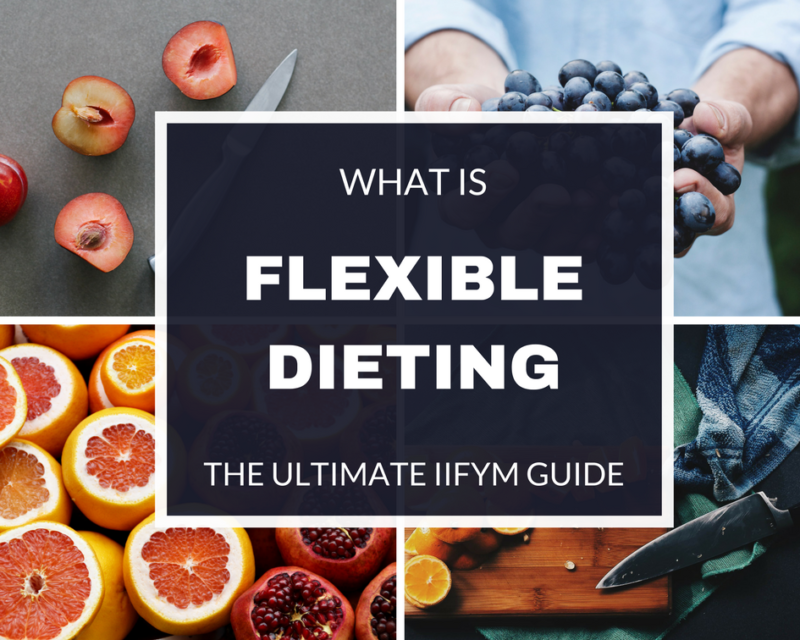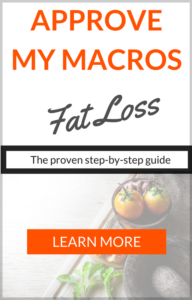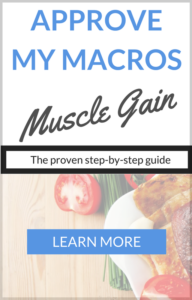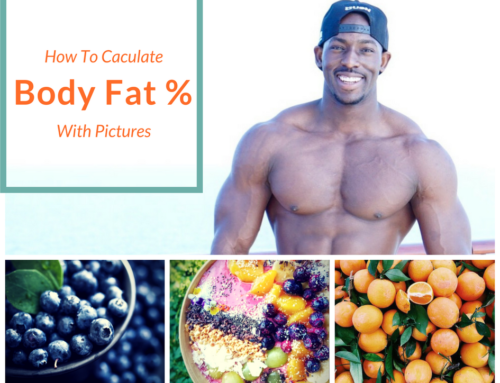If you’ve ever wanted to learn how to practice flexible dieting to eat the foods you love, build muscle, and burn fat, then you’re going to want to read this article!
Have you ever had a friend or known of a person that could eat an entire tub of ice cream, pizza, and burgers everyday if they had a choice and wouldn’t gain an inch on their waistline or even half a pound on the scale?
I’m sure you and I can both think of a few people.
As a result, you try to do the same thing, and the next day, you’re up 5lbs on the scale with a bloated face and seriously wishing you could un-eat that meal.
Tell me I’m wrong.
I’ll wait 😛 .
This can lead you to believe that some foods are bad for you and some foods are good for you.
Thus, you start eating “clean foods” like chicken breast, brown rice, oatmeal, and vegetables.
You also start eliminating foods like sweets, bread, fried foods, and sodas from your diet!
You manage to stick with it 100% and even get some results.
Then 3-4 weeks later…
Progress stalls.
You don’t know why.
You did the work in the gym.
You ate the right foods.
You did the work.
You’re confused, upset, and frantic, and that Starbucks double chocolate muffin is looking pretty damn good.
You give in, and that one Starbucks muffin turns into a week’s worth of binging on all the tasty foods you’ve been restricting yourself from.
And just like that, ladies and gentlemen – A single meal has ruined weeks of hard work, and you’re back to square 1.
And, the yo-yo diet is in full effect.
What if there was an easier way?
A way where you can have that Starbucks muffin and it could actually help aid you with your weight loss.
A way of losing fat and getting in the best shape of your life which was scientifically proven to produce incredible results without yo-yo dieting, pain and suffering, and without restricting yourself from the foods you enjoy.
Well, you know what?
There is.
Let me explain…
There is such a thing as being “too strict” with your diet.
Yup, I said it, according to a study conducted by the Appetite Journal, people who tried to stick to diets that were too strict had higher rates of eating disorders, were depressed, and carried more body fat than those who ate flexibly.
This means if you’re cutting carbs out, putting restrictions on your diet, or following fads such as the Paleo or a meal plan straight from the pages of a magazine, it’s pretty much doomed to fail.
That being said, let me welcome you to the wonderful world of Flexible Dieting.
What is Flexible Dieting?
Flexible Dieting is a nutrition system that requires you to simply count macronutrients (protein, carbohydrate, and fat) to achieve a body composition goal.
This is also known as ‘If it fits your macros’ (IIFYM).
Flexible Dieting is a structure of dieting based on giving your body what it needs to function and change, whether your goal is to lose fat or gain lean muscle and improve performance.
The focus of Flexible Dieting is quantity and not quality.
In a nutshell, Flexible Dieting IIFYM can be summed in four steps:
Step 1: Calculate your TDEE (total daily energy expenditure) based on your current weight and exercise.
Step 2: Calculate your macros in ratios that will help you reach your goal whether it’s fat loss or muscle gain.
Step 3: Change your macros based on your body type.
Step 4: Track your food intake and try to meet your TDEE and macro limits each day.
Counting Macros
Macronutrients or Macros are your protein, fat, and carbohydrates, and each of them has a calorie value.
- 1 Gram of Protein = 4 calories
- 1 Gram of Carbohydrate = 4 calories
- 1 Gram of Fat = 9 Calories
Instead of the typical calorie counting (e.g., Eating 1500 calories a day), Flexible Dieters track their macronutrients (e.g., Eating 150g of carbs + 112.5 g of protein, and 50g of fat = 1500 calories).
The reason Flexible Dieters count macros vs. calories is that it influences more body composition change rather than just weight loss or gain.

Flexible Dieting believes that there is no such thing as foods for weight loss. No good or bad foods, just macro rations.
For example:
Artisan Grilled Chicken from McDonald’s:
37g Protein
44g Carbs
7g Fat
6oz Grilled Chicken & 1 Cup Brown Rice:
38g Protein
45g Carbs
6g Fat
Both have about the same macronutrient profile, so both will achieve the same results in your body composition.
As food enters your body, it’s not processing whether this is healthy all organic food or not. It is simply breaking down the food and processing the macronutrients.
This means you can virtually eat whatever you want so long as you hit your macro intake.
A great example of this was demonstrated in the twinkie diet.
However, to maintain overall health, not just to change your body, I’d recommend using the 80/20 principle.
Approve Tip: Make sure that 80% of all of your food comes from single ingredient whole foods, and 20% can come from the foods you love.
This will ensure that you are getting all of your micronutrients as well.
Why You Should Flexible Diet
Although there are many reasons to Flexible Diet, I’m going to give you my top 5 reasons why you should too.
1. It’s flexible, duh!
Flexible Dieting gives you the opportunity NOT to eliminate your favorite foods and also gives you the opportunity to ADD in foods that can complement your diet.
Contrary to the standard diet, you won’t be cutting out foods from your diet. Instead, you’ll be creating a lifestyle for longterm success.
2. It Works with Your Busy Lifestyle
No longer are the days where you have to restrict yourself from eating your mom’s homemade desserts due to your “strict diet.”
No longer are the days where you have to bring your Tupperware of chicken everywhere you go.
No longer are the days of awkward social events.
With Flexible Dieting, you can literally have your cake and eat it too!
As long as you track those macros.
This also goes for alcohol too.
3. It’s Sustainable
The reason why the top fitness models can stay lean year round is that they practice Flexible Dieting and it doesn’t feel like a diet.
Six months to a year after implementing flexible dieting, the weight is still off.
And because you’re never “dieting,” there’s no reason to ever stop, so this eliminates Yo-Yo dieting as a whole.
4. It Gets You Even Leaner
It gives you a specific number macros to hit, not just a calorie count.
It’s the difference between dropping those last few pounds of stubborn fat and standing still.
5. You Develop a Healthier Relationship With Food
The chances of you binge eating are dramatically reduced, you learn the difference in macronutrient ratios from food to food, and it doesn’t feel like a “diet” because these are the foods you chose.
From my experience and research, it seems to kill the “Diet Binge” that we typically doom ourselves with every New Year.
How to Get Started
1. Calculate your Macros For Your Goals
If you want to learn more about the process, check out The Key To Flexible Dieting or read the guide to setting your macros.
Or use our online macro calculator here.
2. Change your Macros Based on Body Type

This is where a lot of people mess up.
Most calculators don’t factor in your body type.
This is something that you would have to do manually to get accurate numbers.
This is important because whether you’re an Endomorph, Mesomorph, or Ectomorph, we all metabolize food differently even if we are eating the same amount of calories.
That being said, the macro ratios should differ between each one.
3. Track Your Macros
Keeping a daily log of what I eat has helped me out tremendously in my weight loss journey and also in the thousands of clients that I’ve helped transform.
The best way I like to keep track of all of my food that I eat is through an app called Myfitnesspal.
Studies have confirmed that there are many benefits of keeping track of the food you eat and the activity you do.
4. Purchase a Digital Food Scale
If we follow the Approve Tip and are eating 80% of our foods from single ingredient whole food sources, there will be times where we can’t look at the back of a nutritional label to see the macros.
A scale will ensure you accurately track what you eat.

Calculating your Macros For Your Goals
If you want to lose weight, you must first understand that you will need to decrease your caloric intake. If you want to gain weight, you will need to increase your caloric intake.
Simple, right?
The number of calories you consume per day is the deciding factor in losing or gaining weight.
As stated previously, having the right macro number dramatically helps with the body’s composition (e.g., inches around the stomach, thighs, arms, etc.).
To find the optimal macronutrient ratio for you, follow the next steps below.
Find Your Ideal Daily Caloric Intake
The macro calculator is one of the easiest tools to use for anybody wanting to find out how many calories they need on a daily basis.
It calculates your optimal macronutrient ratio’s based on your age, height, weight, gender, and activity level.
HOW THE MACRO RATIOS ARE CALCULATED
THE FOLLOWING FORMULA IS USED:
1. Protein ratio is set at .825 grams per pound of bodyweight.
2. Fats are set at 25% of daily energy expenditure.
3. Carbohydrate grams come from the remainder.
Daily energy expenditure is calculated from your age, gender, height, weight, and exercise output.
Adjusting Macros Based On Your Body Type
After you find your macros, the next step is to manually adjust them for your body type.
Endomorph (You Look At Food And Gain Weight)
- Adjust protein to high
- Add 40g of protein for men and subtract 40g of carbs for men
- Add 20g of protein for women and subtract 20g of carbs for women
Mesomorph (Easy Gainers)
- Adjust protein to high
- Add 20g of protein for men and subtract 20g of carbs for men
- Add 10g of protein for women and subtract 10g of carbs for women
Ectomorph (Hard Gainers)
- Adjust protein to high
Tracking Your Macros
The more consistently you track your food intake, the more likely you are to lose weight. That’s why every successful weight management program suggests that you keep a diary and/or an activity log.
How I track my food is through a simple powerful app called Myfitnesspal.
Simply download the Myfitnesspal from the app store to get started.
Sign up and go to the diary tab. From there, you will see Breakfast, Lunch, Dinner, and Snacks with all having an add food tab underneath. Hit the tab and start searching for the food you are about to eat.
*Approved Tip: always insert food in Myfitnesspal before you actually eat it. This will prevent you from going over and will help you be more accurate with hitting your macros spot on.
Start tracking EVERYTHING you eat! This means tracking zero calorie soft drinks and even vegetables; both have carbs in them that can add up and have an effect on your overall macros.
Myfitnesspal even has a scanner where you can scan the packaged foods that you eat in moderation from time to time.
Weight All Foods
A lot of nutrition information is available on food packaging. However, a scale will ensure you accurately track what you eat.
*Tip: Make sure all food is cooked before weighing for better accuracy!
My Own Experience
I personally had a horrible relationship with food during my first weight loss transformation.
I was doing tons of cardio per day, sometimes twice per day, and if I had to see another plate of tilapia and asparagus, I was going to puke my brains out.
Trust me, I’ve been there before, and weight loss and getting into the best shape of your life doesn’t have to be that miserable.
The Flexible Dieting approach makes life more enjoyable, knowing that you can still participate in family events and not have to request special dishes because of dietary restrictions or not eat at your favorite restaurants, or even canceling out Sunday Football rituals with your friends.

Without overstating it, I feel as if Flexible Dieting has completely changed my outlook on how I see food.
It’s incredibly relieving, and the results that come along with it stick for the long run.
You’ll Love Our Programs
Step-by-step ebooks, or fully customized personal coaching. Let us help you succeed!
Scientific Reference:
- https://www.ncbi.nlm.nih.gov/labs/journals/










Leave A Comment